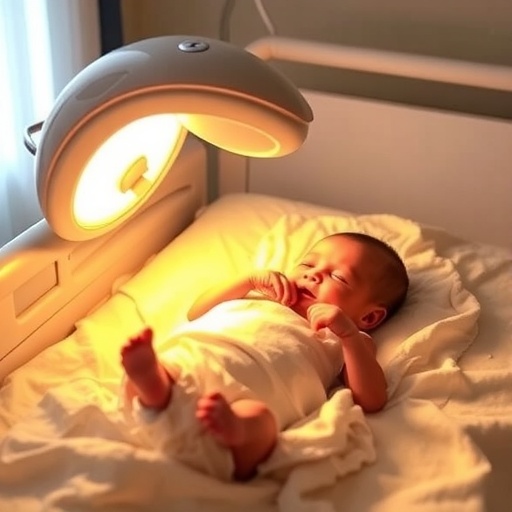In an era where healthcare innovation continuously strives to enhance neonatal care, a groundbreaking systematic review and meta-analysis now places home phototherapy under the scientific spotlight as a potentially transformative approach for managing neonatal hyperbilirubinemia. This comprehensive study meticulously amalgamates data from multiple clinical trials and observational studies to evaluate the efficacy and safety of administering phototherapy treatments within the familiar and comforting environment of a newborn’s home, contrasting it with traditional hospital-based interventions.
Neonatal hyperbilirubinemia, the medical term for elevated bilirubin levels in newborns, represents one of the most common conditions requiring clinical attention during the earliest days of life. Bilirubin accumulation manifests as jaundice, causing a yellow discoloration of the skin and mucous membranes. While often benign and self-limiting, severe hyperbilirubinemia can lead to critical neurological damage if left untreated. Phototherapy—the use of specific wavelengths of light to convert bilirubin into soluble isomers that can be excreted without conjugation—is the gold standard treatment, effectively reducing serum bilirubin levels and preventing kernicterus.
Traditional phototherapy administration usually occurs in hospital settings, often requiring prolonged stay in neonatal care units. However, hospitalization can induce significant parental stress, disrupt early bonding, and carry associated risks such as nosocomial infections. Recognizing these challenges, Spaan et al.’s study investigates whether home-based phototherapy could serve as an equally efficacious, safer, and more humane alternative, thus redefining postnatal care paradigms.
.adsslot_R1wxZ5Bcn4{ width:728px !important; height:90px !important; }
@media (max-width:1199px) { .adsslot_R1wxZ5Bcn4{ width:468px !important; height:60px !important; } }
@media (max-width:767px) { .adsslot_R1wxZ5Bcn4{ width:320px !important; height:50px !important; } }
ADVERTISEMENT
The methodology employed in this review is a model of rigorous scientific synthesis, combining both quantitative data from meta-analyses and qualitative insights from patient and caregiver experiences. The investigators sifted through extensive databases, meticulously selecting randomized controlled trials, cohort studies, and qualitative reports meeting stringent inclusion criteria. Such mixed methods analysis allowed for an enriched understanding not only of treatment outcomes but also of contextual factors influencing therapy success in the home environment.
Safety profile analysis further enhanced the appeal of home phototherapy. Adverse events were rare across both settings, and when present, they were mild and manageable. Crucially, the study emphasizes that patient selection criteria and parental education are paramount; when families receive thorough training on device operation, recognition of warning signs, and adherence monitoring, home phototherapy proves to be a safe backdrop for jaundice management.
The review also offers an exploration of parental psychological outcomes, a dimension often overlooked in neonatal care research. Parents administering phototherapy at home reported decreased anxiety levels, higher satisfaction, and strengthened infant–parent bonding experiences. These psychosocial benefits ripple through the early postnatal period, potentially positively influencing long-term family dynamics and infant development.
From a health economics standpoint, home phototherapy emerges as a potential cost-saving strategy by reducing hospitalization days, relieving pressure on neonatal intensive care units, and decreasing associated healthcare expenditures. These findings resonate with broader healthcare system goals focused on efficiency, patient-centered care, and resource optimization.
Despite these promising results, the authors caution against wholesale adoption without adherence to safety protocols and infrastructure support. Universal access to calibrated phototherapy devices, reliable communication channels for clinical supervision, and emergency response readiness remain non-negotiable requirements to ensure favorable outcomes. The research highlights gaps in technology standardization and healthcare policy frameworks that must be addressed for scalable home phototherapy programs.
Technological advancements in portable phototherapy units examined in this review underscore the critical role of engineering innovations in enabling home treatment. The development of energy-efficient, low-heat-emission devices with user-friendly interfaces diminishes barriers to use and enhances compliance, reflecting an interdisciplinary synergy between clinical medicine and biomedical engineering.
Furthermore, the study delves into the nuances of light dosimetry and its impact on treatment efficacy. Phototherapy operates optimally within specific wavelengths, typically blue light around 460-490 nm. The ability of home devices to deliver consistent irradiance, maintain appropriate distance from the infant’s skin, and achieve sufficient body surface exposure without provoking overheating or dehydration is vital. The review analyzes these parameters, underscoring the need for robust device validation before widespread deployment.
Another pivotal aspect explored is the integration of telemedicine into home phototherapy regimens. Remote monitoring and virtual consultations enable healthcare providers to track bilirubin levels, troubleshoot device issues, and provide timely interventions. Although still in its infancy, such digital health applications exhibit the potential to bridge gaps inherent in home-based care models, ensuring safety nets without necessitating hospital visits.
The authors also reflect on disparities in access to home phototherapy, citing socioeconomic and geographic factors influencing feasibility. While urban, well-resourced populations may benefit disproportionately, efforts must be channelized toward equitable dissemination, especially in low- and middle-income countries where neonatal jaundice contributes substantially to infant morbidity and mortality.
The study opens fertile ground for future research directions, including longitudinal assessments of neurodevelopmental outcomes following home phototherapy, development of standardized training modules for caregivers, and exploration of health system integration strategies. Policymakers and clinicians alike stand at a crossroads, empowered by robust evidence to rethink neonatal jaundice management protocols.
As healthcare continues to evolve toward personalization and decentralization, the emerging evidence supporting home phototherapy exemplifies how careful scientific inquiry can translate into practical, life-enhancing interventions. This research holds profound implications for millions of newborns and their families worldwide, promising safer, more comfortable, and potentially more cost-effective treatment pathways that honor the delicate nature of early life.
Article Title: Home phototherapy for neonatal hyperbilirubinemia: a mixed methods systematic review and meta-analysis.
Article References:
Spaan, J., Westenberg, L.E.H., Ista, E. et al. Home phototherapy for neonatal hyperbilirubinemia: a mixed methods systematic review and meta-analysis. Pediatr Res (2025). https://doi.org/10.1038/s41390-025-04313-5
Image Credits: AI Generated
DOI: https://doi.org/10.1038/s41390-025-04313-5
Tags: alternatives to hospital phototherapybenefits of home healthcare for infantsefficacy of home phototherapyhome phototherapy for neonatal jaundicejaundice in newborns treatment optionsneonatal hyperbilirubinemia treatmentneonatal jaundice managementparental stress in neonatal carephototherapy versus traditional hospital carereducing bilirubin levels in newbornssafety of phototherapy at homesystematic review on phototherapy





